Hi to everyone who is interested in the arrivals of different species to our area. And not just birds! (but mostly!)
But let’s start with our feathered dinosaurs…
Spring migration is just ramping up. That includes the species that travel through our coastal flyway on their way to their northern nesting areas and the ones that come only as far as our island to nest. Interestingly, several species fly up the coast, touch base here and then shoot up the inlets and over the mountains into the Caribou…Yellow-headed Blackbirds are an example, rare, they never stay more than couple days and are shocking in their outrageous plumage! Their song is a humorous, croaky “kiss-me-arse”! This and next month.
In the second and third week of March very large numbers of robins invaded Cortes. Most of these are on their way north. The pair that live at our place is now singing (on territory) and the whole island now is in full symphony. Robins don’t get nearly enough credit for their gorgeous song. Besides their main song they seem to have about four more things to say; squabbling, warning, rain-to-come, and generally – I-feel-good! Take time to just listen and get their song ‘down’ in your mind. There are several species that come later that ‘sound’ like robins and if you’ve taken the time to know the robins these other singers will ‘jump out at you’. Western tanagers and Black-headed Grosbeaks are two in this category, with the latter being the trickier and rarer one. More on them when they arrive in early May.
And finally, migrants are usually silent or with soft chips etc. summer residents/nesters are the ones who you hear actually singing – on territory. Work on memorizing the different songs. I do 90% of my ‘birding’ with my ears. The Cornell website is superb for putting in the name of a species and they give you several songs. Narrow down the species by using the bird checklist that Fred Zwickel, Christian Gronau and I published decades ago. It’s still very accurate as to when species arrive on Cortes. You can use that feature to help narrow down the species to the right one. Remember, species are very fussy as to when they get here. One can predict almost to the day their arrival! Much depends on their food source, i.e. certain insects don’t hatch until spring warms up. Even with Global Overheating (forget the soft pudding ‘Warming’ label) it takes time for species to adapt to new temperature regimes.
Audubon’s Warbler – this species is now here in full force. Both the nesters and the migrants. Once again, you can separate them, by the migrants generally only “tschitck” high up in conifers (they do love alders as well). Residents prefer firs and sing a soft indiscreet warble. The Myrtles will be coming soon but they are only migrants. You can separate the species by looking at their throats…Audubon’s are bright yellow and Myrtle powder white. Check your bird book for other field marks. One good friend of mine, Michael Shepard, can actually separate the “tschitcks” of the two species! eee gads.
Like so…
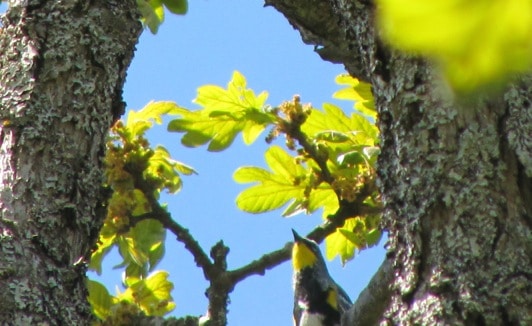
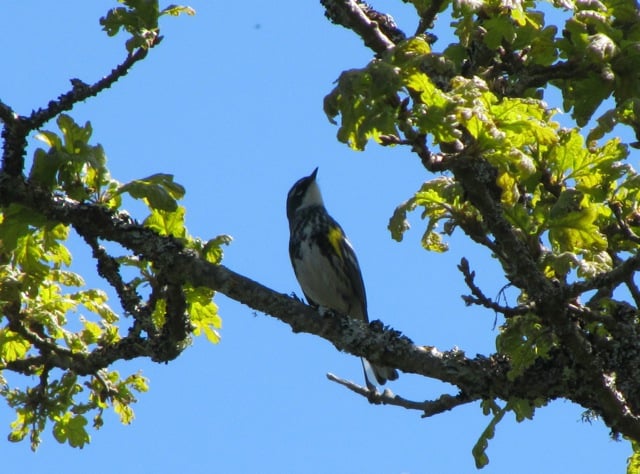
Orange-crowned Warblers are due April 5.
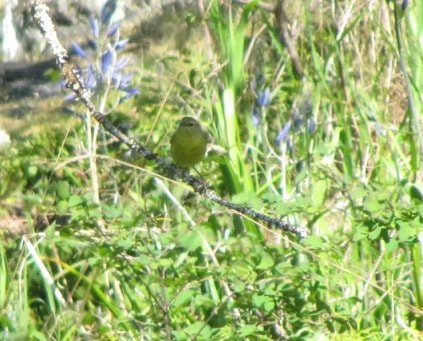
Now for the ‘good stuff’…the ultra rare birds that are like sugar water to a hummingbird – addictive!… On March 20 while we were picnicking on Shark Spit (yes, we did have a nice day in March! – ONE) Kim spotted a Mountain Bluebird ‘flycatching’ on the spit. It would go from little tree to the ground/beach log, darting here and there picking off insects. It made soft calls. It was a male and a delicious super blue. (Females are ‘softer’ in colour.) I’ve only seen the species twice in decades and one of those times was at Robbie and Ann’s gravel pit. They saw it on other occasions. Robbie passed away not long before our sighting, a nice goodbye.
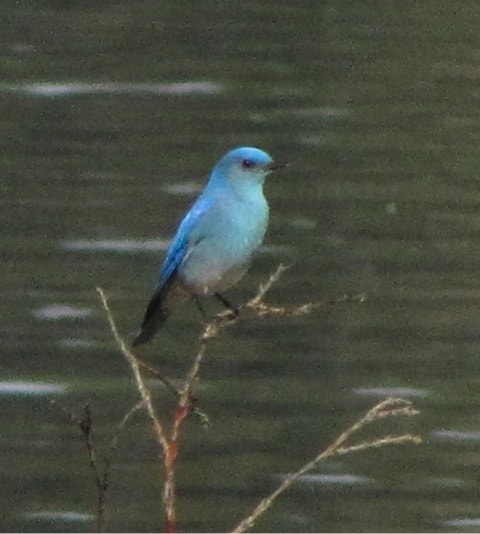
Purple Finches arrived March 25. House Finches have been around in very small numbers all winter at the southern tip of Cortes, perhaps other feeders had them too. Purples sing a strong musical fast warble from high up in conifers. Males are very pink/red in the face area, females are brown & white with heavier stripes, breasts and flanks of males are creamy coloured. House are more orange-ish and sometimes yellow. Their song is not as rich as Purples. They prefer human settlement areas, while Purples prefer forests. And there’s a Purple singing above Bertha’s store, between there and the hall…high up the firs…listen for him–sometimes females will sing too but usually it’s him. Fast, rich, short burst of liquid notes. I guess downtown Manson’s is not so urbanized as we think!
https://www.allaboutbirds.org/guide/Purple_Finch/sounds
I got my first Violet-green Swallows on March 30, but I’ve heard of records than go back to the 16th. They LOVE nest boxes on tall posts/houses with 1 1/8” holes (keeps out starlings). Get yours built and up NOW as there will be waves of them arriving in April looking for homes and they do their selecting early. They have white breast and if you catch the light right–emerald backs with white ‘saddlebags’ on the rump. Their song is like musical clicking of marbles high overhead–unmistakeable.
Tree Swallows used to be on Cortes in the 70’s and now they are just plain gone. More on the demise of swallows on another post.
On April 4 the Ruby-crowned Kinglets started singing, low in bushes, a very musical “Peabody-peabody-peabody”. This time of year is the best time to observe the male’s small ‘ruby patch’ on the crown as they display often, otherwise they tuck it away.
Red-winged Blackbirds are back in full force.
There’s a flock of about 25 Trumpeter Swans in the Manson’s area, check for them at the lagoon or fields.
And just to prove there’s equality across the species… On March 20 we observed a Harbour Porpoise off the mouth of the Gorge. This is a secretive cetacean, usually singly, dark grey, small curved dorsal fin, takes about 3-5 ‘breaths’, close to shore and never approaches boats, just seems to disappear into the murky green water and is very difficult to spot again. Hard to get closer than 200 yards. Look for it on very calm days off the ferry near land. In Greenland you can buy them all nicely chopped up at the fish store.
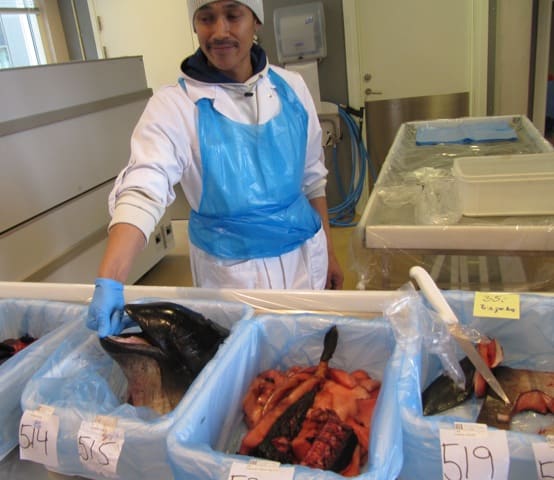
It’s been a rather long ‘note’ but I wanted to give some tips on how to improve your skills. My next ‘note’ will be briefer.
Don’t hesitate to contact me with your sightings or queries…
All photographs are by author and may be reproduced as long as there’s no monetary gain. Otherwise permission and royalties need to be addressed. Thank you, GPS.



